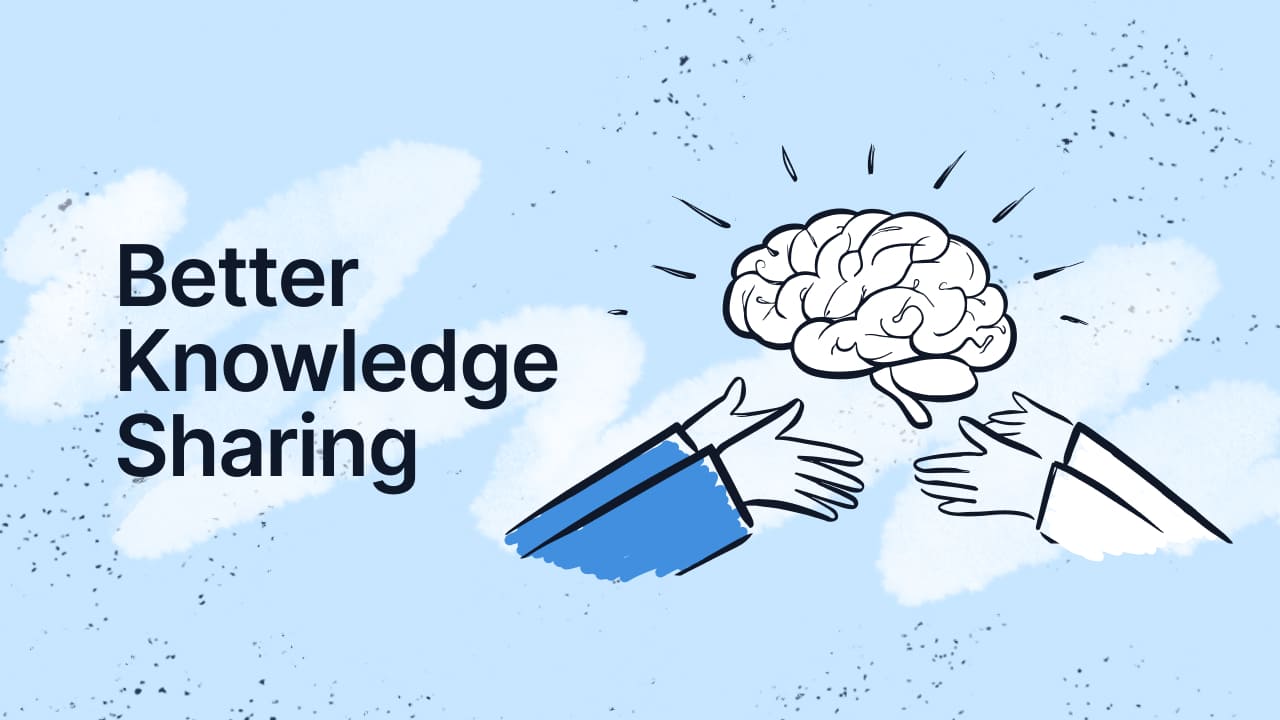A Knowledge Management framework is a structured approach that helps organizations manage their knowledge resources effectively. These frameworks guide many processes in an organization, such as organizing, storing, and sharing knowledge, to ensure that all valuable information is accessible and usable when needed.
A well-chosen framework can improve decision-making, enhance service delivery, and support an organization's culture of continuous improvement and innovation.
In this article, we'll explore various Knowledge Management frameworks, provide insights into how each framework operates, and guide you in selecting the approach that best fits your organization’s needs.

Knowledge Management frameworks
Choosing the right Knowledge Management framework depends on your organization’s specific needs and objectives. Whether you’re looking to integrate Knowledge Management into Enterprise Service Management, enhance customer support, foster innovation, assess maturity, or align with business goals, there’s a framework designed to guide you.
Let us help you find the one that fits best.
ITIL (Information Technology Infrastructure Library)
Scope of ITIL Knowledge Management
ITIL, a framework widely used in IT Service Management (ITSM), defines Knowledge Management as a structured process that sits within the service transition stage.
Its main goal is to ensure that the right knowledge is available at the right time to support all other ITSM processes. Essentially, it's about creating, organizing, maintaining, and sharing knowledge within the organization so that everyone has access to accurate and relevant information.
Key components:
- Knowledge Management strategy: Defines how knowledge is managed and aligned with the organization's goals.
- Knowledge capture and storage: Focuses on gathering and storing knowledge systematically.
- Knowledge sharing and dissemination: Ensures that knowledge is accessible to those who need it.
- Knowledge maintenance and improvement: Regularly updates and improves knowledge to keep it relevant.
Context for use:
ITIL Knowledge Management is ideal for organizations that want to standardize their process as part of a broader ITSM approach (and thus, under an ITSM framework). It’s particularly effective in industries where Service Management is key, such as IT, healthcare, or finance, providing a structured way to handle knowledge that supports various Service Management activities.

APQC's Knowledge Flow Process Framework
APQC's Knowledge Flow Process Framework is a comprehensive approach to managing knowledge within an organization. Developed by the American Productivity & Quality Center (APQC), this framework outlines a cyclical process for knowledge management, ensuring that knowledge is continuously created, shared, and utilized effectively throughout an organization.
Key components:
- Create: Generating new knowledge through research, innovation, and experience.
- Identify: Recognizing valuable knowledge assets within the organization.
- Collect: Gathering and documenting identified knowledge in a systematic manner.
- Review: Evaluating and validating collected knowledge for accuracy and relevance.
- Share: Distributing knowledge across the organization through various channels.
- Access: Ensuring that knowledge is easily retrievable by those who need it.
- Use: Applying knowledge in practical situations to solve problems and make decisions.
Context for use:
APQC's Knowledge Flow Process Framework is suitable for organizations of various sizes and industries that want to implement a structured approach to Knowledge Management. It's particularly effective in environments where continuous learning and innovation are crucial, such as technology companies, consulting firms, or research institutions.
SECI Model
The SECI Model is a framework for understanding how knowledge is created and shared within an organization. It describes four modes of knowledge conversion:
- Socialization: Sharing tacit knowledge through direct interaction.
- Externalization: Converting tacit knowledge into explicit forms (e.g., writing it down).
- Combination: Merging different pieces of explicit knowledge to create new knowledge.
- Internalization: Learning and internalizing explicit knowledge, turning it into tacit knowledge.
Emphasis on "Ba" (Shared Context):
A key aspect of the SECI Model is the concept of "ba," which refers to a shared context where knowledge creation and sharing occur. This can be a physical space, like a meeting room; a virtual space, like an online collaboration platform; or even a mental space, like shared values or beliefs.
Application in Knowledge Management:
The SECI Model is especially useful for organizations that prioritize continuous learning and innovation. By understanding and applying these four modes of knowledge conversion, organizations can create a dynamic environment where both tacit and explicit knowledge are continually developed and shared, driving growth and improvement.

Knowledge-Centered Service (KCS)
Scope of KCS
Knowledge-Centered Service (KCS) is a methodology specifically designed to integrate knowledge management directly into customer support and service processes.
Unlike ITIL, which covers a wide range of ITSM processes, KCS focuses solely on knowledge capture and reuse during customer interactions. The idea is to capture knowledge as it’s created, typically during the resolution of customer issues, and then reuse that knowledge to solve future problems more efficiently.
Key components
- Knowledge base creation and maintenance: Building and maintaining a repository of knowledge articles.
- Knowledge capture at the point of contact: Documenting solutions during customer interactions.
- Knowledge reuse in resolving customer issues: Using the knowledge base to solve similar problems in the future.
- Continuous improvement of knowledge assets: Regularly updating knowledge articles based on new information.
Context for use
KCS is perfect for organizations where customer service is a top priority, such as help desks, contact centers, or any support-driven business. It fosters a collaborative environment where support staff contribute to and benefit from a shared knowledge base, ultimately improving service efficiency and customer satisfaction.
Knowledge Management Maturity Model (KM3)
The Knowledge Management Maturity Model (KM3) is a tool for assessing how mature an organization’s knowledge management practices are. It breaks down maturity into five levels:
- Initial: Knowledge Management is informal and unstructured.
- Reactive: Efforts are made to address specific knowledge management issues, but they are still uncoordinated.
- Organized: There are formal processes in place for managing knowledge.
- Managed: Knowledge Management is integrated into daily operations and is regularly monitored.
- Optimizing: Continuous improvement is the focus, with knowledge management practices being refined and enhanced regularly.
Assessing maturity and developing a roadmap:
KM3 helps organizations evaluate where they currently stand in terms of knowledge management and develop a roadmap to move toward higher maturity levels. This is especially valuable for organizations looking to systematically improve their knowledge management processes.
Wiig Model
The Wiig Model focuses on three main aspects of Knowledge Management:
- Building knowledge: Gathering and organizing information that is relevant and useful.
- Marshaling knowledge: Making sure knowledge is readily accessible when and where it’s needed.
- Applying knowledge: Using knowledge effectively to achieve business objectives.
Aligning with organizational goals
The Wiig Model strongly focuses on aligning knowledge management activities with the organization’s overall goals. It ensures that the knowledge being managed and applied is directly contributing to the organization’s success, making it a strategic tool rather than just an operational one.

How to Choose a Framework
Now that you know a few frameworks, you might wonder how to select the right one. This decision will depend on your organization’s unique needs and objectives.
To make an informed choice, start by understanding what each framework offers and how it aligns with your goals. Consider the nature of your business, the challenges you face, and the specific outcomes you hope to achieve through knowledge management.
While each Knowledge Management framework has its unique focus, they all share common goals like enhancing organizational efficiency and promoting knowledge sharing. For example, ITIL integrates knowledge management into IT Service Management processes, while KCS focuses on improving customer support through knowledge reuse. The SECI Model emphasizes converting tacit and explicit knowledge, and KM3 assesses an organization’s knowledge management maturity.

Implementing Knowledge Management
Assessing organizational needs
Let's say you chose the framework you think is right. Now, before diving into implementation, it’s important to understand where your organization currently stands in terms of knowledge management.
This involves:
- Conducting a knowledge audit: This process helps identify existing knowledge assets, gaps, and potential areas for improvement. It includes mapping out where knowledge resides within the organization, who holds it, and how it's currently shared (or not shared).
- Involving stakeholders: Engage employees at all levels, from front-line staff to top management. Their input is invaluable in understanding knowledge flows, bottlenecks, and opportunities for enhancement.
Developing a Knowledge Management strategy
With a clear understanding of your organization's needs, the next step is to create a comprehensive Knowledge Management strategy:
- Set clear objectives: Define what you want to achieve with KM. This could include improving customer service, accelerating product development, or reducing operational inefficiencies.
- Align with organizational goals: Ensure that your KM objectives support broader business objectives. This alignment is crucial for securing buy-in from leadership and ensuring long-term success.
- Create an action plan: Develop a detailed roadmap for implementing KM initiatives, including timelines, resource allocation, and responsibility assignments.

Fostering a knowledge-sharing culture
For knowledge management to be successful, it needs to be supported by a culture that values collaboration and sharing.
- Encourage collaboration: Implement practices that facilitate knowledge exchange, such as regular team meetings, cross-departmental projects, and mentoring programs.
- Recognition and rewards: Develop a system to acknowledge and reward employees who actively contribute to the organization's knowledge base. This could include incorporating knowledge sharing into performance reviews or creating specific awards for knowledge contributions.
Choosing the right tools and technologies
Selecting the appropriate tools is another crucial aspect of implementing Knowledge Management.
- Evaluate software options: Consider factors like ease of use, scalability, and features that align with your specific needs. Options might include document management systems, enterprise social networks, or dedicated KM platforms.
- Consider compatibility: Make sure the chosen tools integrate well with existing systems and workflows to minimize disruption and maximize adoption.
Your chosen tools should facilitate easy access, sharing, and knowledge management across the organization.

Measuring effectiveness and continuous improvement
Finally, it’s essential to measure the effectiveness of your Knowledge Management initiatives. To do this, you can:
- Define Key Performance Indicators (KPIs): Establish metrics to measure the impact of your KM efforts. These could include time saved in finding information, reduction in duplicate work, or improvements in customer satisfaction scores.
- Gather feedback and iterate: Regularly collect input from users and stakeholders. Use this feedback, along with KPI data, to make continuous improvements to your KM systems and processes.
Conclusion
Choosing and implementing a Knowledge Management framework doesn't have to be overwhelming. While it does require commitment, resources, and a willingness to adapt, it can also be a transformative journey for your organization. When done right, knowledge management can unlock significant benefits:
- Enhanced decision-making through better access to information
- Improved efficiency by reducing time spent searching for knowledge
- Increased innovation as ideas are more easily shared and built upon
- Preserved institutional knowledge, even as employees come and go
- Stronger collaboration across departments and teams
Remember, the process is ongoing, and continuous improvement will keep your knowledge management practices relevant and effective as your organization grows. Start small if needed, focus on quick wins to build momentum, and gradually expand your efforts.














.jpg?upsize=true&upscale=true&width=780&height=205&name=ITIL%20Foundation%20Exam%20(2).jpg)
